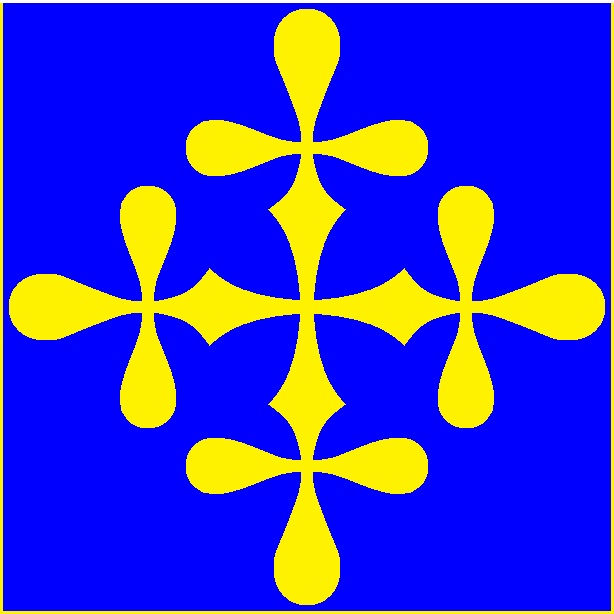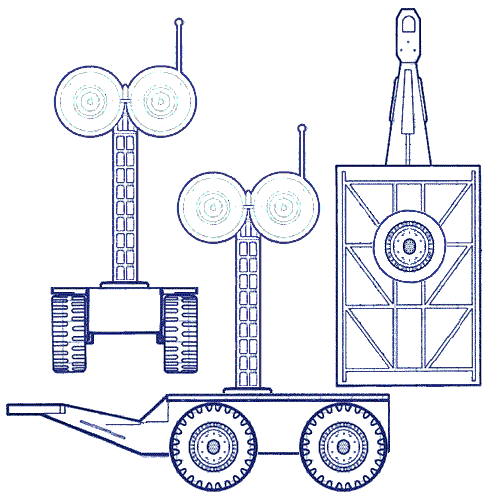 | RZ-11 Coastal Defender
Radar Array. |  |
|---|
| United Galaxies Council. | United Galaxies Council. |
|---|
Background:
The RZ-11 Coastal Defender Radar Array was an Isræli innvoation, intended to detect incoming Hamas rockets without itself being detected; The RZ-11 was named "Coastal Defender" as part of the secrecy. | | RZ-11 "Coastal Defender" Radar Array (overhead view lacks array for detail). |
|---|
The Israelis positioned most of the units, on their now common trailers, along the coast in an attempt to fool their enemies into believing that they were intended to detected ships at sea.
While this ruse fooled no one (and in fact angered some, even allies), the Israelis nevertheless continued with the program. They were testing a new theory of tracking targets, using a new laser-based theory; When the wide-angle lasers bounced off a target, laser detectors would "see" it, and focused tracking lasers would then acquire the target. Other, separate, anti-missile laser batteries would then "wash" the missile, dazzling the targeting array, welding a control surface stiff, prematurely detonating the warhead, or otherwise disabling the rocket.
The project wasn't the success the Israelis had hoped, but it was able to detect that 'a' threat was coming with as much as 30 minutes warning, allowing civilians to get into shelter. When the United Nations re-formed as the United World Government, the Security Council procured several dozen Coastal Defenders on a testbed basis; They were little more impressed than the Israelies themselves, but when they augmented the laser detector with a standard radar array, it proved to be most formidable; Unfortunately, it also proved to be the perfect targeting system for anti-radiation missiles, which is why the Israelis tried lasers to begin with (lasers are far more difficult to detect). A common tactic is to shut down the radar array until a threat is detected, then activating the radar for tracking. Once the rocket's course and speed is determined, the whole unit is shut down and moved, before counter-radar batteries (HARM's mostly) can be fired- The unit is light enough to move by hand in an emergency (though not very far).
The rotator (the part that actually allows the radar array to change the direction it is pointing) looks like the wheels because it uses a wheel rim, mounted in reverse (that is, the side that normally goes out now goes in). The tower holder assembly is welded to this, allowing the tower to be folded down for extended transport. It's not the most efficient design, but it works.
Type: Ladar/Radar Support System.
Crew: None necessary; can be automated.
MDC By Location: |
Table
Tower
Radar Dishes (2)/Ladar Knob | 100
50
50 each | Wheels (4)
Tow Gear
| 50 each
50
|
| Speed and Statistical Data: |
Top Speed: Per towing platform.
Top Safe Towing Speed: 80 mph.
Clearance: 20 feet with tower erected, 4 feet 3.25 inches with tower down.
Width: 4.25 feet.
Length: 20 feet.
Weight: 500 lbs (1/4 ton). | Cargo: Crew supplies only.
Power Plant: Any small generator.
Propulsion: N/A.
Flight System: N/A.
Cost and Availability: 60,000credit; Takes about 2 months to build.
Black Market Cost and Availability: Could be as little as 10% to 10 times as much; Fairly rare. |
Sensor Systems:
The Coastal Defender does not have any form of weapons nor self-defense; The only way for them to survive an attack is to run away. Fortunately, the system is disposable, if all else fails. |
01. Ladar: A laser-based version of radar. It appears as a 'knob' just above the left radar dish (on the viewers right).
Purpose: Target Detection.
Effect: 85% effective.
Rate Of Fire: 2,000 attacks per melee.
Range: 50,000 feet
Payload: Unlimited.
| 02. Radar: Once a target is detected, the radar array can be engaged to track the target's range and relative position for about 30 seconds; From this, the speed and direction can be determined and relayed to another unit for shoot-down.
Purpose: Target Tracking.
Effect: 95% effective (00% against unfriendly stealthed craft under normal conditions).
Rate Of Fire: 2,000 attacks per melee.
Range: 50 miles.
Payload: Unlimited. |
| Features: |
- ESM: Radar Detector. Passively detects other radars being operated.
- Virtual Map: Displays a continuously-updating map of all bodies ahead for the pilot. Takes data from and gives data to other ships in the area. Effective navigation of 85% as updates come. Good to 500 miles. Specific range can be adjusted in 1 mile increments.
| - User Display Panel: Displays ladar, radar, targeting information, and system information for the crew member; The display can be folded down and out of the way when not needed.
- Full range optic sensory suite: Infrared, ultra violet, Magnification, night sight, color filters, thermal imager. Range is about 200 miles for MOST sensors.
|
Combat Bonuses to other platforms: The Coastal Defender does not itself have any combat profile, but does aid others with theirs;- +2 Strike.
- +Automatic Initiative.
|